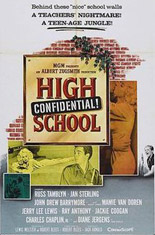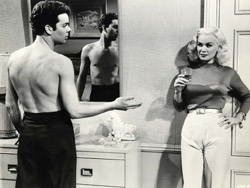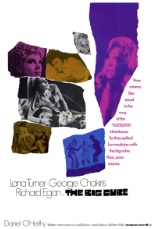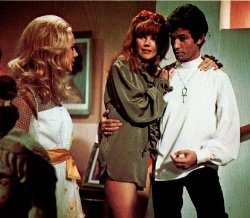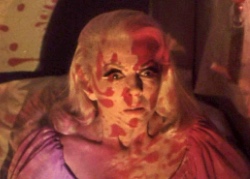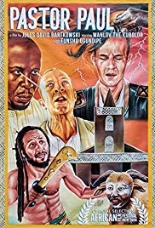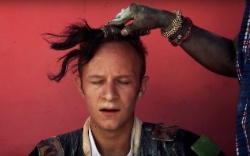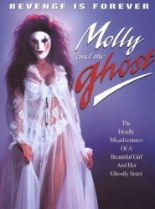
 In Molly and the Ghost, which sounds like the greatest ’80s NBC sitcom premise that never was, 30-something Molly (one-and-done Lee Darling) finds her happy life as a successful California Realtor and loving wife turned tail-over-teakettle by the unexpected arrival of her “barely 17” sister, Susan (Ena Henderson, 1989’s Fatal Exposure), at her doorstep. Claiming an epic row with Dad, Susan needs a place to crash; Molly happily offers the guest bedroom since it’s just for a night …
In Molly and the Ghost, which sounds like the greatest ’80s NBC sitcom premise that never was, 30-something Molly (one-and-done Lee Darling) finds her happy life as a successful California Realtor and loving wife turned tail-over-teakettle by the unexpected arrival of her “barely 17” sister, Susan (Ena Henderson, 1989’s Fatal Exposure), at her doorstep. Claiming an epic row with Dad, Susan needs a place to crash; Molly happily offers the guest bedroom since it’s just for a night …
… until it’s not. And until Susan pockets her older sister’s cash and jewelry, then attempts to do the same to Molly’s husband, Jeff (Ron Moriarty, Silent Night, Deadly Night Part 2), once she finally meets him. From our vantage point, Susan first plots to get her paws on him when — fresh from emerging topless from an afternoon Jacuzzi soak — she walks in on him in his tighty-whities, ready to rub up against his spouse’s loins on the living room couch. The teen girl’s motivation would click with viewers if Jeff were some ripped, abs-aplenty hunk, but ummm … he’s not. No offense to the photo clerks of ShopRite, but Jeff looks like a photo clerk of ShopRite, whereas his wife, even with her 1991 hair, looks like Anne-Marie Martin of TV’s Sledge Hammer! To be clear, that’s not a bad thing. (But that Darling never acted again is; she has some talent!)
 One night, while Molly’s out showing a house to prospective buyers, Susan’s in showing her goods to prospective semen depositor Jeff. Despite her best efforts in black lingerie, he’s just not into it, but to Molly, it looks like a compromising position all the same when she walks in on it. The next morning, Molly gives her immature li’l sis a good talking-to; Susan retaliates as all siblings in this situation would: by hiring a hitman. She finds the freelance assassin in the back pages of a shoplifted copy of War magazine. (Actually, the camera closes in on classifieds advertising military collectibles, but writer/director Don Jones either hoped no one would notice or assumed, not without merit, that his 16mm film’s intended audience could not read.)
One night, while Molly’s out showing a house to prospective buyers, Susan’s in showing her goods to prospective semen depositor Jeff. Despite her best efforts in black lingerie, he’s just not into it, but to Molly, it looks like a compromising position all the same when she walks in on it. The next morning, Molly gives her immature li’l sis a good talking-to; Susan retaliates as all siblings in this situation would: by hiring a hitman. She finds the freelance assassin in the back pages of a shoplifted copy of War magazine. (Actually, the camera closes in on classifieds advertising military collectibles, but writer/director Don Jones either hoped no one would notice or assumed, not without merit, that his 16mm film’s intended audience could not read.)
The ponytailed hitman, John (Daniel Martine, 1989’s Cage), accepts the phoned-in assignment for $5,000, the downpayment for which Susan acquires by borrowing it from Molly (!) under the pretense of needing it “for computer school.” Beyond the dough, all John requires to get started is the mark’s name and photo. Susan eagerly complies — too eagerly, as it turns out — by tearing a photo of the sisters in two … and sending him the wrong half! Effectively ensuring her own demise, she realizes her mistake much too late.
Ergo, the Ghost portion of the title comes into play.
 It is here that Jones (Schoolgirls in Chains) takes his thriller on a turn: a hard left into the supernatural, because, yeah, why the fuck not? Stuck-up even in death, the wraith Susan is given a second shot at sister sabotage when a matronly spirit (Carole Wells, The House of Seven Corpses) allows her to haunt Molly and Jeff rather than rest eternally. “You are so young to be so spiteful,” the boss-lady spirit tells her pupil. “You have much to learn and I fear it will be a painful process for all involved.” In other words, Heaven Can Wait for hussies.
It is here that Jones (Schoolgirls in Chains) takes his thriller on a turn: a hard left into the supernatural, because, yeah, why the fuck not? Stuck-up even in death, the wraith Susan is given a second shot at sister sabotage when a matronly spirit (Carole Wells, The House of Seven Corpses) allows her to haunt Molly and Jeff rather than rest eternally. “You are so young to be so spiteful,” the boss-lady spirit tells her pupil. “You have much to learn and I fear it will be a painful process for all involved.” In other words, Heaven Can Wait for hussies.
Because skinflint filmmakers like Jones can’t foot the bill for fancy hauntings, much of Susan’s from-the-grave shenanigans amount to her laughing in mirrors. Now, there is a scene that depicts worms crawling from holes in her cheeks, but this animation is so chintzy, it really just looks like her face is pooping. At any rate, our wedded heroes don’t know what to do about this imposition. Then Jeff recalls the VHS copy of Ghostbusters, and just as suddenly, Molly and the Ghost becomes a comedy as well — and a body-switching one, at that! — before settling down as a drama. Maybe it’s best not to ask. Just watch! For all its shortcomings and corner-cutting, it’s never boring. —Rod Lott
Get it at Amazon.
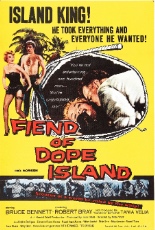
 Somewhere in the Caribbean, psychotic pot farmer and arms dealer Charlie Davis (Bruce Bennett, The Alligator People) is The Fiend of Dope Island, who physically abuses the native slaves he calls his employees. (Comparisons to Michael Fassbender’s Oscar-nominated role in 12 Years a Slave are not out of line.) Meanwhile, right-hand man David (Robert Bray, My Gun Is Quick) tries to right his boss’ wrongs. Besides being the only white guy on the payroll, David stands out for wearing a yacht captain’s hat as if he’s the top half missing from an “& Tennille” marquee.
Somewhere in the Caribbean, psychotic pot farmer and arms dealer Charlie Davis (Bruce Bennett, The Alligator People) is The Fiend of Dope Island, who physically abuses the native slaves he calls his employees. (Comparisons to Michael Fassbender’s Oscar-nominated role in 12 Years a Slave are not out of line.) Meanwhile, right-hand man David (Robert Bray, My Gun Is Quick) tries to right his boss’ wrongs. Besides being the only white guy on the payroll, David stands out for wearing a yacht captain’s hat as if he’s the top half missing from an “& Tennille” marquee.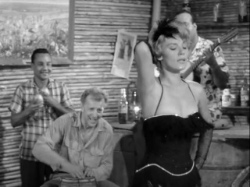 Although directorial duties fell to oater specialist Nate Watt (Hopalong Cassidy Returns, et al.), the script was co-written by Bennett, who sure gave himself a meaty part as the antagonist. Seeing him bark orders — each punctuated with the crack of his trusty whip — is one thing, but Bennett is at his ham-hock best during the dance numbers, maniacally laughing and feverishly bongoing his way into an orgiastic frenzy as Glory shakes her groove thang. Dope Island may be nothing more than a melodrama, but his Reefer Madness-styled overdelivery infuses the picture with a nutty flavor, kicking it over into the stuff of many a men’s adventure magazine cover. —Rod Lott
Although directorial duties fell to oater specialist Nate Watt (Hopalong Cassidy Returns, et al.), the script was co-written by Bennett, who sure gave himself a meaty part as the antagonist. Seeing him bark orders — each punctuated with the crack of his trusty whip — is one thing, but Bennett is at his ham-hock best during the dance numbers, maniacally laughing and feverishly bongoing his way into an orgiastic frenzy as Glory shakes her groove thang. Dope Island may be nothing more than a melodrama, but his Reefer Madness-styled overdelivery infuses the picture with a nutty flavor, kicking it over into the stuff of many a men’s adventure magazine cover. —Rod Lott
